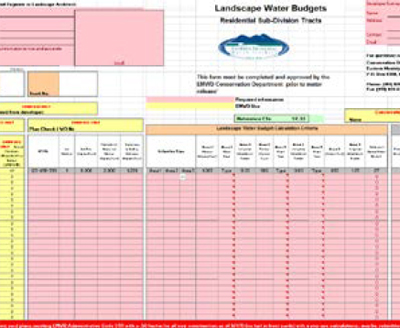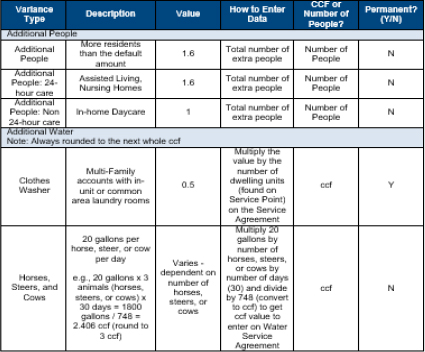Variances and Long-Term Maintenance
Once the initial water budget is determined, agencies have policies in place regarding changes to allocations. These adjustments are crucial to the long-term maintenance of water budgets and in ensuring that customers remain aware of the reasons behind their water charges.
There are many types of adjustments that agencies may allow customers to apply for. The case studies and links to policies below describe what each individual agency allows. The two major general categories of adjustments include:
- Water budget adjustment: Also known as variances, these change the water budget a customer receives. Only changes that result in an increased water budget (either outdoor or indoor) are necessary. Generally variances are requested by submitting a form or otherwise contacting the agency and often require some sort of proof or documentation to support the budget change.
- Number of people in the household: If the number of people in the household (i.e., PPH) increases, the indoor water budget must be likewise increased. Generally some sort of proof (e.g., school records, driver’s licenses, birth certificates, leases, etc.) is necessary.
- Irrigated area: If the irrigated outdoor area increases, the customer has need for a larger outdoor water budget. Proof for this variance may include providing a map or sketch, calculating square footage of the new area, and a confirmation visit from the agency.
- Pool filling: Sometimes treated more like a billing adjustment, this variance is generally only allowed one time or once every specified time period (e.g., 5 years) when a pool (or spa) is filled.
- Medical need: A medical need for increased water use requires documentation often in the form of a doctor’s note.
- Licensed care facility (child, adult, or elder): A licensed care facility that provides documentation for its increased need for water can receive an increased water budget.
- Large animals, including livestock: Often specified as animals over 100 pounds, this variance results in an increased water allotment based on the type and number of animals.
- Billing adjustment: An adjustment to the water bill, whether in the form of a credit or reduction in the rate charged for a particular amount of water used, is generally retroactive and only takes effect after approval by the agency.
- High usage adjustment: The adjustment comes in the form of billing at the budget rate even though the budget was exceeded due to unknown excess usage. The change to the bill commonly takes place only after the problem is fixed (requires documentation). A leak adjustment is one type.
- Courtesy adjustment: This adjustment occurs when the reason behind the high water use remains a mystery, but the agency grants a one-time bill adjustment as a courtesy to the customer.
When adjustments expire varies from agency to agency. Generally, billing adjustments are one time alterations, while changes to the water budget (i.e., variances) are either permanent or require updated information (i.e., renewal) after a certain amount of time.
In the first year of BBR structure implementation, Elsinore Valley Municipal Water District received over to 4,000 variance requests from 11% of total customer accounts. The majority of the variances were for adjusting the number of people in the household, with the second highest number for pool filling and refilling. It was determined that additional clarification and communication was needed for the pool filling and refilling variance category, as customers perceived a variance application was necessary to “certify” the pool itself in order to receive the additional water budget allocation. In the second year, the number of variances decreased to 1,400, or 4% of customer accounts, with the majority of variances still submitted for the adjustment of the number of people in a household.
Other agencies’ specific experiences can be found in the table below:


